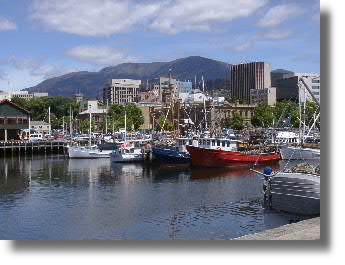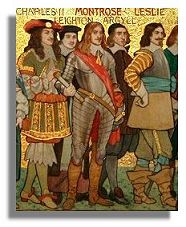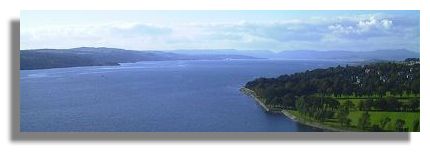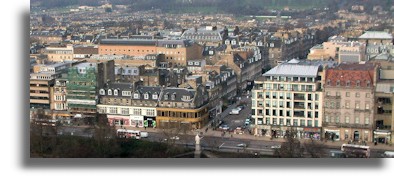
For comparability with other cities around the world, Hobart has been defined as the urban and semi-urban area extending from Brighton in the north to Margate, South Arm and Clifton Beach in the south and from Collinsvale and Fern Tree in the west to the airport and Seven Mile Beach in the east. Of the names of the 98 municipalities, suburbs and neighbourhoods in the Greater Hobart area, 26 (26.5%) can be found in Scotland, are based on Scottish family names or have some other connection with Scotland. Some of the names are used in other parts of the British Isles as well, but at least 12 them (12.2%) are unique to Scotland or are readily identifiable with places in Scotland that are based on the same names.
Official suburbs and other localities with names that occur only in Scotland and not elsewhere in the British Isles, and/or are definitely or most probably of Scottish origin are:
- Berriedale - the name of a small coastal village on the north-east coast of Scotland, in the former county of Sutherland; also the name of a place in the Orkney Islands. There is no documented evidence that the Hobart suburb takes its name from one of the places in Scotland but a Scottish origin is nevertheless likely. The name seems to have been well-established by 1834 when the Berriedale Inn was opened (Australia for Everyone website).
- Browns River - although Brown is a very common English as well as Scottish family name, there is a definite Scottish connection in the case of Browns River, a southern suburb of Hobart in the municipality of Kingston. Browns River was named after the noted Scottish botanist Robert Brown who explored the area a week after Hobart was founded. The name was changed to Kingston in 1851 by the Governor, Sir William Thomas Denison (Australia for Everyone website). The modern suburb of Browns River is a resurrection of the area's original name.
- Dynnyrne - as explained by Kennedy & Kennedy (2006, p. 90), this name "follows from a house built by R.L. Murray in the late 1820s, and its subsequent application to his whole estate. It was a self-styled corruption by Murray of Dunnerne (or Dunearn) in Fife, the seat of the first baronet, Sir William Murray, his claimed ancestor."

- Geilston Bay - Geilston is a village in Argyll & Bute, west of the town of Dumbarton and therefore not far from Glasgow. Geilston House in Geilston (seen in the illustration here) is now owned by the National Trust for Scotland (NTS). There is a direct family connection between Geilston Bay in Hobart and the NTS property since the inlet of Geilston Bay, and thus the Hobart suburb, was named after Colonel Andrew Geils. P.R. Eldershaw (1966), in his entry in the Australian Dictionary of Biography, states that Colonel Andrew Geils "was born probably in India, the eldest son of Lieutenant-General Thomas Geils of the Madras artillery in the East India Co.'s service and later of the Ardmore, Geilston and Dumbuck estates, Dumbartonshire, Scotland." (p. 435). Colonel Geils was appointed Commander of the settlement of Hobart Town in 1812, and lived on property which he called "Geilston Park" after the family estate near Dumbarton, Scotland.
- Glenorchy (derived from the river Orchy in Argyll & Bute; this river flows into Loch Awe). It is thought that Governor Lachlan Macquarie, while visiting Tasmania in 1811, bestowed the name in honour of his wife's family home in Scotland (Kennedy and Kennedy, 2006). The 1904 Australian Handbook described the little town as "thoroughly English-looking"!
- Granton (a district of the City of Edinburgh). The Australia for Everyone website provides the following explanation of the suburb's name: "Takes its name from Granton Railway Station. The name of the station was selected when the railway line through the area was built to honour Charles Grant, the General Manager of the Tasmanian Government Railways." The suburb was therefore not named after the district in Edinburgh. Grant is a well-known Scottish family name, of Norman origin, the clan taking its name from the French word grand ('great').
- Green Point (Shetland Islands) -it may be sheer coincidence, of course, that the only place in the British Isles with this descriptive name happens to be in Scotland. The suburb takes its name from the estate of Green Point on the Derwent River (Australia for Everyone website).
- Lauderdale (Scottish Borders). There is indeed a connection with Scotland as explained in the Australia for Everyone website: "Takes its name from the estate of pioneer settler Robert Mather, at Muddy Plains on Ralphs Bay. Mather was born in Lauder, Scotland. The post office here was originally known as Ralph's Bay. Ralphs Bay Canal and Roches Beach were combined under the name Lauderdale in May 1960." (Australia for Everyone)
- Leslie Vale - there are places called Leslie in Aberdeenshire and Fife; also Lesliedale in the Orkney Islands. Leslie is a territorial name from the Barony of Garioch in north-east Scotland, dating back to the end of the 12th century (Scarlett, 1975).

- Montrose (Angus). The Hobart suburb was named after the Montrose Estate owned by Robert Littlejohn, who is believed to have been born in Montrose, Scotland (Australia for Everyone website). The illustration shows the Duke of Montrose seen with his contemporaries).
- Mount Stuart - there are places in Clackmannanshire, Dumfries & Galloway and South Lanarkshire with this name. Mount Stuart is also an amazing Gothic mansion house on the Isle of Bute, created on the site of a building dating back to the reign of Queen Anne, at the start of the 18th century. In an article retrieved from Wikipedia in April 2013, the following explanation is provided for the origin of the suburb's name: "The name Mount Stuart comes indirectly from a Governor of Bombay (Mumbai) in India, Mountstuart Elphinstone. Mountstuart was the fourth son of the eleventh Lord Elphinstone, and was born in Dunbartonshire, Scotland. A ship, Mountstuart Elphinstone, was named in honour of the Governor, and in 1836, this ship visited Hobart town. The Mountstuart Elphinstone brought the news that the unpopular Lieutenant-Governor George Arthur, was ordered to return to London. This allowed reversal of some of his unpopular Laws. To celebrate, locals named two roads to the north west of the town 'Mount Stuart Road' and 'Elphinstone Road'."
- Rose Bay - Rose is a well-established Scottish clan, records of the name going back to the 12th century. One wonders whether the Hobart suburb, like its namesake in Sydney, was named in honour of George Rose, Under-Secretary for the British Treasury.
It is possible that some of the following suburbs and neighbourhoods could also have a direct or indirect Scottish connection, but these names can be found in other parts of the British Isles as well:
- Clifton Beach - there are places called Clifton in the Scottish Borders, Orkney Islands and Stirling but the name is used in many English counties as well, most famously the town of Clifton (now a suburb of Bristol) on the River Avon.

- Firthside - there are places called Firth in Angus, the Scottish Borders and Shetland Islands, as well as a Firth House and Mains in Midlothian, Firth Ness in the Shetland Islands, Firthfield in Angus, Firthhead and Firthope Rig in Dumfries & Galloway and Firthybrig Head in the Scottish Borders. Place names with Firth as an element are also found in northern England, but less frequently than in Scotland where the word "Firth", meaning an estuary or wide inlet of the sea, derives from the Old Norse which also gave rise to the word "fjord". The illustration above is of the Firth of Clyde. The suburb of Firthside was formerly known as Little Groningen because of post-WW2 Dutch immigration to the area.
- Rosetta - there are two villages in Scotland with this name, in the Scottish Borders and Dumfries & Galloway respectively, though the name, both in Scotland and in Hobart, could refer to Rosetta in Egypt. The village in Dumfriesshire, Scotland was in fact given its name by a General Johnstone, who served in Egypt in 1800 during the Napoleonic Wars (Nicolaisen, 2001, p. 85). The name of the Hobart suburb was actually derived from the Rosetta Seminary and/or the Rosetta jam factory, but considering that the suburb adjoins Berriedale, Glenorchy and Montrose, there could well be a Scottish connection.
- Springfield (Argyll & Bute, Dumfries & Galloway, Fife, Highland and Perth & Kinross) also very commonly found in England and Wales. Springfield is a popular place name in the USA as well. "Said to be named after an old town that once existed near Scottsdale. No reason is given for the name being adopted." (Australia for Everyone website)
A final category of suburban names comprises places that can be found in Scotland but which, in Hobart's case, definitely or most probably have no connection with Scotland.
- Austin's Ferry - there is an Austincroft in Highland; also Austin's Bridge in Devon, England. This suburb is named after an English convict, James Austin (1776-1831), who began the first ferry service there in the early 1800s across the River Derwent and who died a wealthy man. (Kennedy and Kennedy, 2006).
- Bonnet Hill - there is a place in Moray called Bonnethill. According to the Australia for Everyone website, however, the name is descriptive of the shape of the hill on which the suburb is located.
- Claremont (Fife, also Claremont Park in Edinburgh). Claremont is also found as an element in place names in southern England. The Hobart suburb was named after Claremont House, which was built in the 1830s by local settler Henry Bilton, who named it after Claremont Estate near Esher, Surrey (one of the royal homes of England). (Wikipedia article on Claremont, Tasmania, retrieved in March 2007).
- Clarence - there is a Clarencefield in Dumfries & Galloway. The City of Clarence (Hobart's eastern suburbs) was named for royalty however, as explained in the Wikipedia article on City of Clarence, retrieved in April 2013: "The City of Clarence is named indirectly after King William IV of the United Kingdom. From 1789 until 1830, when he ascended the throne, he was titled His Royal Highness The Duke of Clarence and St Andrews. It was during this period that the British settlement of Hobart was founded in 1803."
- Glebe (Highland, Orkney Islands and Shetland Islands) also found in England and Ireland. Glebe is an Old English word for land put aside for church use.
- Kingston, Kingston Beach and Kingston Heights - there are several places in Scotland called Kingston, in Angus, East Lothian, Moray and Renfrewshire; Kingston is also a district of the City of Glasgow. However the name is also used frequently across southern England and is found in Ireland and Wales as well. Kennedy and Kennedy (2006) are inclined to attribute the name to King George III. The Australia for Everyone website provides a more plausible explanation of the origin of the name: "Originally it was named Browns River after the noted Scottish botanist Robert Brown who explored the area a week after Hobart was founded. However, the name was changed to Kingston in 1851 by the Governor, Sir William Thomas Denison. The name Kingston was advocated by the then Police Magistrate, Mr Lucas. Although his exact reason for deciding on the name of Kingston is unknown, there are many theories. His parents, Thomas and Anne Lucas, the district's first settlers, lived at Norfolk Island before coming to Van Diemen's Land and the capital of Norfolk Island was Kingston. Another possible reason is that Thomas was born in Surrey, England in a village close to New Kingston. It had been settled in 1808 by Thomas Lucas and his family, who were evacuated from Norfolk Island. He named his property 'Kingston', after the settlement on Norfolk Island."(Australia for Everyone, retrieved in April 2013). Kingston on Norfolk Island, in turn, was probably named for King George III, though a reference to its founder, Lieutenant Philip Gidley King, may also have been intended.
- Montagu Bay - there is a Montague in Perth & Kinross. There is also one in East Sussex, England; both are spelt Montague. There is no Scottish connection, however, since the name honours Algernon Sidney Montagu (1802-1880), Attorney General and judge, who was born at Cambridge, England (Wikipedia article on Montagu Bay, Tasmania, retrieved in January 2007).

- New Town (East Lothian, also The New Town, a World heritage site in Edinburgh - as pictured here- plus many other places spelt Newtown) but New Town is found far more frequently in England than in Scotland. New Town/Newtown is one of the most commonly recurring urban place names throughout the English-speaking world and in the majority of instances is simply a descriptive name. This also seems to have been the case with Hobart's New Town, historians being in agreement that the name was acquired in order to distinguish the various new settlements around Cornelian Bay from the original settlement of Hobart Town (Kennedy & Kennedy, 2006).
The role played by Scotsmen in establishing and developing Tasmania's capital city is further attested by the names of several main roads, both in the city centre and in the suburbs. Examples include Argyle Street (City Centre), Campbell Street (City Centre), Clydesdale Avenue (Glenorchy), Gordons Hill Road (Flagstaff Gully), Macquarie Street (City Centre), Melville Street (City Centre), Murray Street (City Centre) and Roslyn Avenue (Blackmans Bay/Kingston Beach). Governor Lachlan Macquarie was responsible for bestowing several of these names when he visited Hobart in 1811. Several parks and reserves also bear Scottish or Scottish sounding names, for example Cameron Park (Berriedale), Roseneath Park (Austins Ferry), St Andrews Park (City Centre) and Waverley Flora Park (Mornington).
Acknowledgments:
- Kennedy, Brian and Kennedy, Barbara (2006). Australian Place Names. (ABC Books, Sydney).
- Nicolaisen, W.F.H. (2001). Scottish Place-Names: Their Study and Significance. (John Donald, Edinburgh).
- Scarlett, James D. (1975). The Tartans of the Scottish Clans. (Collins, Glasgow and London).
- Australian Dictionary of Biography - Online Edition.
- Australia for Everyone
- Hobart and Launceston Street Directory, 1st Edition, 2008 (UBD, Universal Publishers Pty Ltd)
- Websites, place name gazetteers and published Ordnance Survey maps of British and Irish cities, towns, villages and counties.
© Ian Kendall
Melbourne, Australia, July 2004
Revised May 2013If you wish to contact Ian about his research, his e-mail address is ian.kendall1@bigpond.com.



